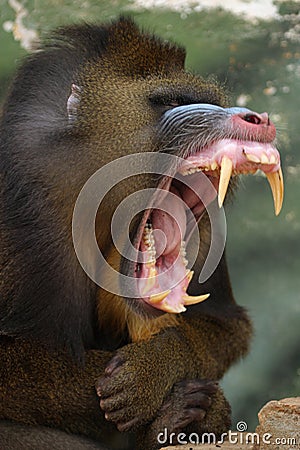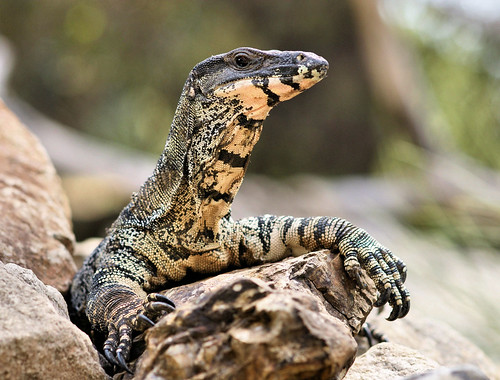Post by Runic on Nov 18, 2013 23:31:52 GMT 5
Mandrill

The mandrill (Mandrillus sphinx) is a primate of the Old World monkey (Cercopithecidae) family,[4] closely related to the baboons and even more closely to the drill. It is found in southern Cameroon, Gabon, Equatorial Guinea, and Congo. Mandrills mostly live in tropical rainforests and forest-savanna mosaics. They live in groups called hordes. Mandrills have an omnivorous diet consisting mostly of fruits and insects. Their mating season takes place from June to October.
Both the mandrill and the drill were once classified as baboons in genus Papio, but recent research has determined they should be separated into their own genus, Mandrillus.[4] Mandrills are the world's largest monkeys. Charles Darwin wrote in The Descent of Man that "no other member in the whole class of mammals is coloured in so extraordinary a manner as the adult male mandrills."[5] The mandrill is classified as vulnerable by IUCN.
The mandrill is the most colorful primate. It has an olive green or dark grey pelage with yellow and black bands and a white belly. Its hairless face has an elongated muzzle with distinctive characteristics such as a red stripe down the middle and protruding blue ridges on the sides. It also has red nostrils and lips, a yellow beard and white tuffs. The areas around the genitals and the anus are multi-colored, being colored red, pink, blue, scarlet, and purple.[6] They also have pale pink ischial callosities.[6] The coloration of the animal is more pronounced in dominant adult males. Both sexes have chest glands which are used in olfactory communication. These, too, are more prominent in dominant adult males.[7] Males also have longer canines than females, with an average of 4.5 cm (1.8 in) and 1.0 cm, respectively.[8]
The mandrill has one of the greatest sexual dimorphisms among the primates.[9] Males typically weigh 19–37 kg (42–82 lb), with an average mass of 32.3 kg (71 lb). Females weigh roughly half as much as the male, at 10–15 kg (22–33 lb) and an average of 12.4 kg (27 lb).[10] Exceptionally large males can weigh up to 54 kg (119 lb).[11][12][13] The average male is 75 to 95 cm (30 to 37 in) long and the female is 55–66 cm (22–26 in), with the short tail adding another 5–10 cm (2.0–3.9 in).[14][15] The shoulder height while on all fours can range from 45 to 50 cm (18 to 20 in) in females and 55 to 65 cm (22 to 26 in) in males. The male Mandrill is the heaviest monkey in the world, although its total length is relatively short due to its vestigial tail and, due to its high sexual dimorphism, baboons such as the Chacma and Olive average around the same weight. Compared to the largest baboons, the mandrill is more ape-like in structure, with a muscular and compact build, shorter, thicker limbs that are longer in the front and almost no tail.[16][17][18] Mandrills can survive up to 31 years in captivity. Females reach sexual maturity at about 3.5 years.
Cape Leopard

The leopard, Panthera pardus, is a member of the Felidae family and the smallest of the four "big cats" in the genus Panthera, the other three being the tiger, lion, and jaguar .Cape Leopards or Panthera Pardus Melanotica are much smaller than the African Leopard (Panthera Pardus) found in the Kruger National Park. These have an average weight of 61kg for males, while their Cape counterparts average just over half that. In the Western Cape, leopards are significantly smaller, males averaging 32 kg and females 20 kg, which makes them in many instances smaller than a large male Caracal.

The mandrill (Mandrillus sphinx) is a primate of the Old World monkey (Cercopithecidae) family,[4] closely related to the baboons and even more closely to the drill. It is found in southern Cameroon, Gabon, Equatorial Guinea, and Congo. Mandrills mostly live in tropical rainforests and forest-savanna mosaics. They live in groups called hordes. Mandrills have an omnivorous diet consisting mostly of fruits and insects. Their mating season takes place from June to October.
Both the mandrill and the drill were once classified as baboons in genus Papio, but recent research has determined they should be separated into their own genus, Mandrillus.[4] Mandrills are the world's largest monkeys. Charles Darwin wrote in The Descent of Man that "no other member in the whole class of mammals is coloured in so extraordinary a manner as the adult male mandrills."[5] The mandrill is classified as vulnerable by IUCN.
The mandrill is the most colorful primate. It has an olive green or dark grey pelage with yellow and black bands and a white belly. Its hairless face has an elongated muzzle with distinctive characteristics such as a red stripe down the middle and protruding blue ridges on the sides. It also has red nostrils and lips, a yellow beard and white tuffs. The areas around the genitals and the anus are multi-colored, being colored red, pink, blue, scarlet, and purple.[6] They also have pale pink ischial callosities.[6] The coloration of the animal is more pronounced in dominant adult males. Both sexes have chest glands which are used in olfactory communication. These, too, are more prominent in dominant adult males.[7] Males also have longer canines than females, with an average of 4.5 cm (1.8 in) and 1.0 cm, respectively.[8]
The mandrill has one of the greatest sexual dimorphisms among the primates.[9] Males typically weigh 19–37 kg (42–82 lb), with an average mass of 32.3 kg (71 lb). Females weigh roughly half as much as the male, at 10–15 kg (22–33 lb) and an average of 12.4 kg (27 lb).[10] Exceptionally large males can weigh up to 54 kg (119 lb).[11][12][13] The average male is 75 to 95 cm (30 to 37 in) long and the female is 55–66 cm (22–26 in), with the short tail adding another 5–10 cm (2.0–3.9 in).[14][15] The shoulder height while on all fours can range from 45 to 50 cm (18 to 20 in) in females and 55 to 65 cm (22 to 26 in) in males. The male Mandrill is the heaviest monkey in the world, although its total length is relatively short due to its vestigial tail and, due to its high sexual dimorphism, baboons such as the Chacma and Olive average around the same weight. Compared to the largest baboons, the mandrill is more ape-like in structure, with a muscular and compact build, shorter, thicker limbs that are longer in the front and almost no tail.[16][17][18] Mandrills can survive up to 31 years in captivity. Females reach sexual maturity at about 3.5 years.
Cape Leopard

The leopard, Panthera pardus, is a member of the Felidae family and the smallest of the four "big cats" in the genus Panthera, the other three being the tiger, lion, and jaguar .Cape Leopards or Panthera Pardus Melanotica are much smaller than the African Leopard (Panthera Pardus) found in the Kruger National Park. These have an average weight of 61kg for males, while their Cape counterparts average just over half that. In the Western Cape, leopards are significantly smaller, males averaging 32 kg and females 20 kg, which makes them in many instances smaller than a large male Caracal.









